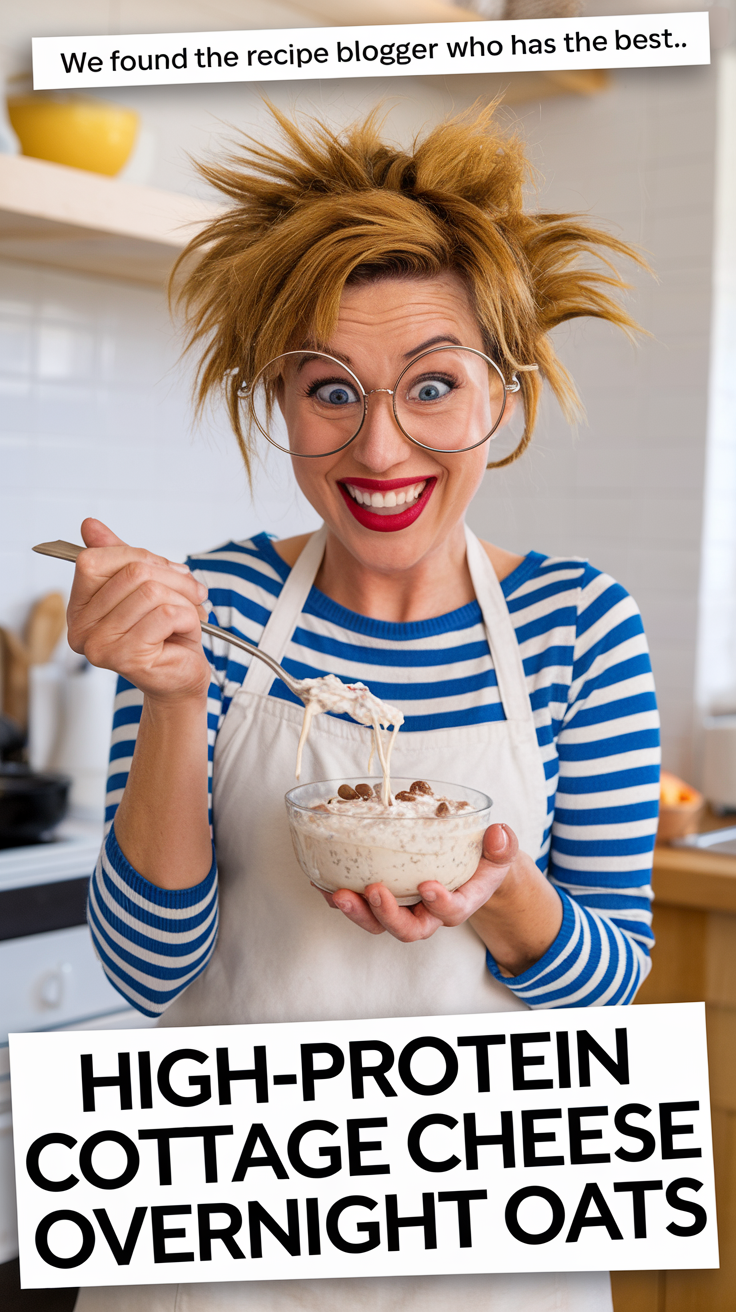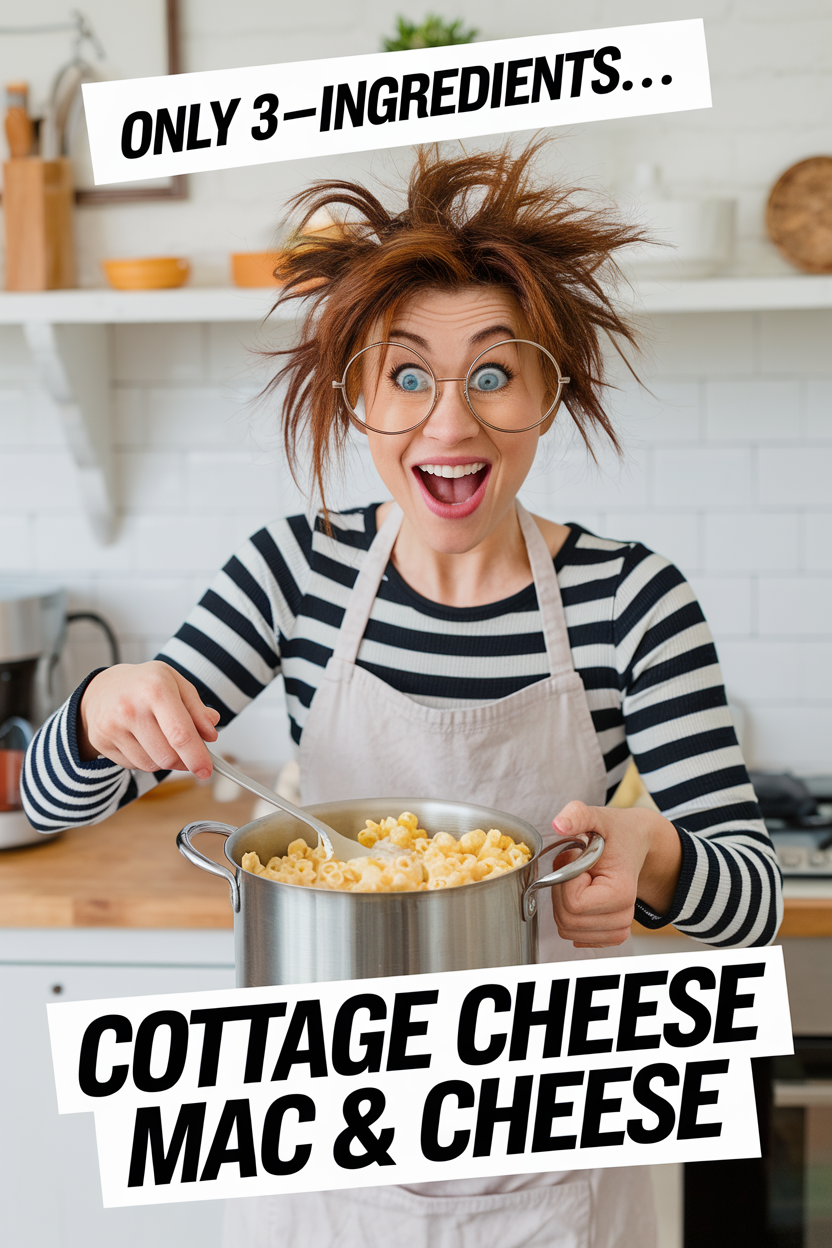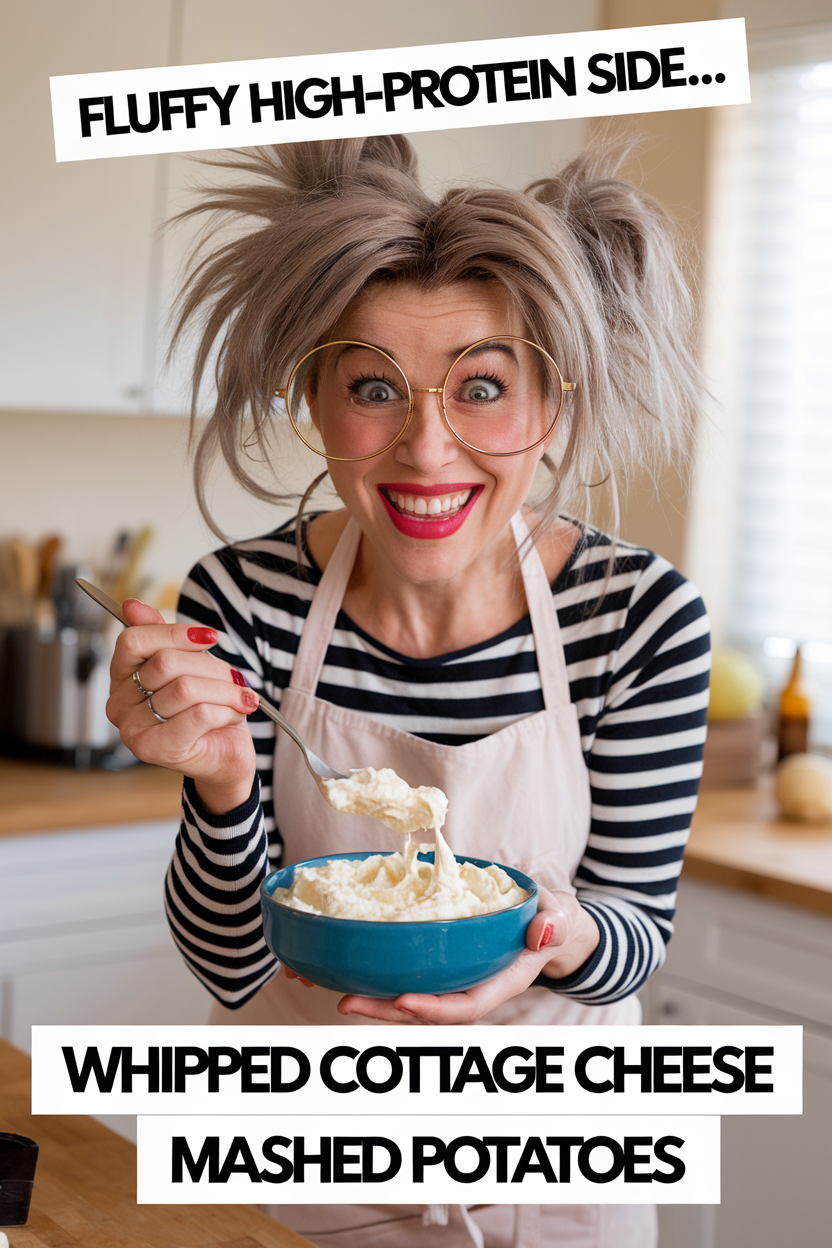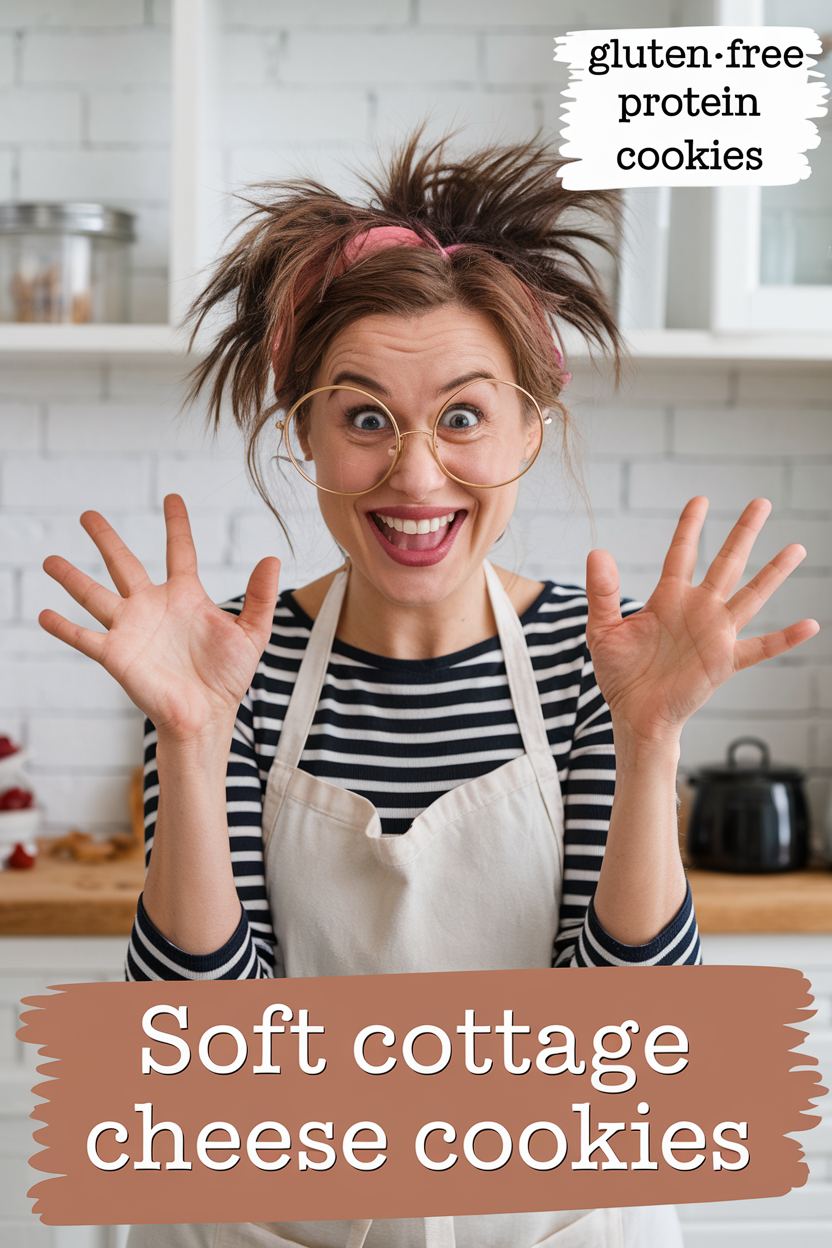Cottage cheese is a true kitchen chameleon. This mild, creamy cheese is packed with protein and nutrients yet low in carbs and sugars nutrisense.io. It has long been celebrated as a versatile and healthy ingredient, perfect for sweet or savory dishes.
Whether you’re looking to boost protein in breakfast, sneak nutrition into dessert, or lighten up a comfort food, cottage cheese can probably do it! Its slightly tangy flavor and creamy texture make it easy to blend into batters, sauces, and dips.
Below you’ll find 20 inventive recipes from clever food bloggers that turn humble cottage cheese into something extraordinary. From low-carb pizza crusts to high-protein ice cream, these ideas show how cottage cheese can fit a variety of diets (high-protein, low-carb, gluten-free, vegetarian, etc.).
Get ready to be inspired by these creative twists – you might never look at a tub of cottage cheese the same way again!
How to Read This List: Each recipe idea is numbered and includes a brief overview, nutritional highlights, why it stands out, who it’s best for, improvement ideas, tips for success, and a link to the full recipe (just look for “Read the full recipe here.”).
1. Creamy Cottage Cheese Scrambled Eggs (Fluffy High-Protein Breakfast)
- Brief Overview: Fluff up your morning eggs by folding in cottage cheese! In this recipe, beaten eggs are scrambled with a scoop of creamy cottage cheese and a sprinkle of chives. The cottage cheese melts into the eggs, adding a velvety texture and a mild cheesy flavor nutrisense.io. It’s an easy one-pan breakfast – just cook the mixture in a little butter until soft curds form.
- Nutritional Profile: This simple scramble is low-carb and high-protein. One serving (half the recipe) has around 16 grams of protein and only ~2 grams of carbs allrecipes.com. The healthy fats from eggs and cottage cheese make it satisfying for hours.
- Why It’s “Best”: Adding cottage cheese makes the eggs extra creamy and more nutritious than using heavy cream or just eggs alone nutrisense.io. You get more protein and calcium in every bite without changing the eggy flavor. It’s a clever way to upgrade plain scrambled eggs into a muscle-friendly meal.
- Who It’s For: Perfect for low-carb dieters, keto folks, or anyone who wants a protein-packed breakfast without bread. Also great if you find plain eggs boring – the cottage cheese adds a nice twist.
- Suggested Improvements or Variations: Toss in some veggies (like spinach or diced peppers) or serve with a side of turkey bacon to round out the meal nutrisense.io. If you prefer spice, add a dash of hot sauce or paprika. You can also experiment with different herbs (basil or dill) for new flavor.
- Tips and Tricks: Use small-curd cottage cheese so it melts more easily into the eggs. Cook on medium-low heat and stir gently – this keeps the texture soft and prevents drying out. Don’t worry if the curds are visible at first; they will mostly blend in as the eggs set. Season well with salt and pepper (eggs and cottage cheese are both mild, so they need seasoning).

Source Link: Read the full recipe here nutrisense.ioallrecipes.com
2. Fluffy Cottage Cheese Pancakes (High-Protein Pancakes)
- Brief Overview: These pancakes sneak cottage cheese into the batter for extra fluff and protein. The recipe blends cottage cheese, eggs, oats, and a touch of cinnamon into a smooth batter. Cooked like regular pancakes on a griddle, they turn out golden and fluffy. The cottage cheese keeps them moist inside, almost like little protein-packed crepes. Top with berries or a drizzle of syrup and you’ve got a delicious breakfast treat.
- Nutritional Profile: A serving of these pancakes packs about 25 grams of protein and a good amount of fiber from the oats nutrisense.io. They have a balanced mix of carbs, protein, and healthy fats, making them more filling and nutritious than traditional pancakes nutrisense.io. They can be made gluten-free if you use certified GF oats.
- Why It’s “Best”: Unlike typical pancakes that are mostly carbs, this recipe offers a more balanced, high-protein breakfast nutrisense.io. The cottage cheese adds tenderness and protein without a strong taste. These pancakes have been praised for having a great texture and keeping you full longer than usual pancakes. It’s a clever way to enjoy a comfort breakfast and still meet your protein goals.
- Who It’s For: Ideal for fitness enthusiasts, high-protein dieters, or kids who love pancakes but need more protein. Also great for those who want gluten-free pancakes – just use oats and no wheat flour. If you’re watching sugar, you can skip sugary toppings and go with fresh fruit and a little Greek yogurt on top.
- Suggested Improvements or Variations: You can blend in a ripe banana or pumpkin puree for extra flavor and nutrients. Try adding blueberries or chocolate chips to the batter for variety. If you want even more protein, you could mix a spoon of protein powder into the batter (you may need a bit of extra liquid). For a vegan twist, some bloggers replace eggs with flax eggs and cottage cheese with a plant-based alternative, though results will vary.
- Tips and Tricks: Blend the batter well so that the cottage cheese curds and oats break down – this ensures a smooth, uniform batter. Let the batter sit for a few minutes to thicken (the oats will absorb moisture). Cook on a medium-hot skillet with a little butter or oil; wait until you see bubbles on top before flipping. These pancakes can be made ahead and frozen – just reheat in a toaster or microwave for quick breakfasts.

Source Link: Read the full recipe here nutrisense.io
3. Raspberry Cottage Cheese Smoothie (Protein-Packed Shake)
- Brief Overview: Think of this as a yogurt smoothie, but using cottage cheese for even more protein. It blends cottage cheese, milk, and frozen fruit (like raspberries or strawberries) into a thick, creamy shake. A bit of vanilla and honey can be added for sweetness. The result is a luxuriously creamy smoothie with a slight tang, similar to a yogurt shake. It’s ready in about 3 minutes and makes a perfect breakfast or post-workout drink sugarfreelondoner.comsugarfreelondoner.com.
- Nutritional Profile: Each generous glass has around 14 grams of protein just from the cottage cheese sugarfreelondoner.com (even before adding any protein powder), plus vitamins and fiber from the fruit. It’s relatively low in fat (depending on the cottage cheese used) and has natural carbs from fruit. Compared to a typical fruit smoothie, this one has significantly more protein and will keep you full longer.
- Why It’s “Best”: Blending cottage cheese into a smoothie might sound unusual, but it’s a game-changer for creaminess and protein. The cottage cheese gives it an almost milkshake-like texture and a fresh tangy flavor sugarfreelondoner.com. It’s a great alternative to protein powder – you get protein from a whole food source sugarfreelondoner.com. Many people (even kids) are surprised how tasty and milkshake-creamy it is, despite being so healthy.
- Who It’s For: Great for fitness enthusiasts needing a recovery shake, or busy mornings when you want a quick, balanced meal. It’s also kid-friendly – one blogger noted her kids requested this smoothie every morning after trying it sugarfreelondoner.com. If you’re on a low-fat or high-protein diet, this smoothie fits right in. It’s also easy to make vegetarian (it already is!) and can be made gluten-free (contains no gluten ingredients).
- Suggested Improvements or Variations: Feel free to swap the fruit – try mango and pineapple for a tropical twist, or bananas and peanut butter for a “PB&J” style protein shake. You can throw in a handful of spinach to sneak in greens (the fruit will mask the taste). For extra sweetness or flavor, add a dash of cinnamon or a squirt of honey/maple syrup. If you want even more protein, add a scoop of your favorite protein powder – but you might find it’s rich enough without it.
- Tips and Tricks: Use a good blender to get everything super smooth – you shouldn’t detect any curds once blended. If the smoothie is too thick, add a splash more milk; if it’s too thin, add more frozen fruit or a few ice cubes. For a colder, ice-cream-like treat, use frozen cottage cheese (freeze it in ice cube trays) and then blend – it turns into a frosty shake. Serve immediately for the best texture. Also, cottage cheese has sodium, so taste before adding any extra salt (some people put a pinch in smoothies to bring out sweetness, but you likely won’t need it here).

Source Link: Read the full recipe here sugarfreelondoner.comsugarfreelondoner.com
4. High-Protein Cottage Cheese Overnight Oats (Make-Ahead Breakfast)
- Brief Overview: This recipe stirs cottage cheese into overnight oats, creating a creamy, pudding-like breakfast that’s prepped the night before. You combine rolled oats, milk, cottage cheese, chia seeds, a little vanilla and sweetener, plus berries in a jar and let it sit in the fridge overnight. By morning, the oats are soft and everything is slightly thickened. The cottage cheese blends in, so you get a luscious, cheesecake-like creaminess with your oats. It’s a grab-and-go meal that tastes a bit like a fruity parfait.
- Nutritional Profile: Thanks to the cottage cheese (and often an optional half-scoop of protein powder in the mix), these overnight oats boast 20+ grams of protein per serving nutrisense.io. The oats and chia seeds contribute complex carbs and fiber, while cottage cheese adds protein and calcium. It’s fairly low in fat (depending on the cottage cheese) and has natural sweetness from berries. Overall, it’s a well-rounded nutritious breakfast that will keep you full and energized.
- Why It’s “Best”: If you have a sweet tooth in the morning, this feels like eating dessert for breakfast, but it’s secretly healthy. The cottage cheese makes the oats super creamy and filling, without needing lots of sugar or cream. It’s incredibly convenient – mix it at night and breakfast is ready when you wake up. This recipe is also highly customizable; you can change up flavors endlessly. For busy folks, the meal prep factor and the satiating protein make it a winner nutrisense.io.
- Who It’s For: Perfect for meal preppers, students, or anyone with a busy schedule (since it’s prepared ahead). Great for vegetarians who want more protein in the morning. Also a good choice for those on a high-protein or moderate-carb diet. If you normally skip breakfast or get hungry mid-morning, try this – the combination of fiber and protein is very satisfying.
- Suggested Improvements or Variations: You can flavor these overnight oats in so many ways. Try adding cocoa powder for a chocolate version, pumpkin puree and spice for a fall twist, or use mashed banana for natural sweetness. Swap the berries for any fruit you like (chopped peaches, apples with cinnamon, etc.). For a lower-carb version, you could use flaxseed or almond flour instead of some of the oats, though the texture will change. If you prefer it warm, you can briefly microwave it in the morning – the cottage cheese will melt in even more.
- Tips and Tricks: Use old-fashioned rolled oats (quick oats can get too mushy). When mixing, make sure the cottage cheese is evenly distributed – you can even give it a quick blend if you want it completely smooth. A pinch of salt in the mixture can enhance the sweetness of the oats. If it comes out too thick in the morning, stir in a bit more milk. These can last about 2-3 days refrigerated, so you could make a few jars for the week. For crunch, add nuts or granola on top right before eating.

Source Link: Read the full recipe here nutrisense.io
5. Garlic & Herb Whipped Cottage Cheese Dip (Guilt-Free Savory Dip)
- Brief Overview: Say goodbye to sour-cream dips – this recipe uses whipped cottage cheese as a creamy base for an herb dip. You take a tub of cottage cheese, add garlic, fresh herbs like basil and thyme, a squeeze of lemon juice, and black pepper, then blend until completely smooth. The result is a thick, spreadable dip (similar to a herbed cream cheese spread or a ranch dip) that’s cool, savory, and creamy. It’s fantastic with veggie sticks, crackers, or as a sandwich spread.
- Nutritional Profile: Unlike standard party dips that can be heavy in fat, this cottage cheese dip is high in protein (about 15 g per serving) and much lower in fat nutrisense.io. It has no mayonnaise or sour cream – just cottage cheese and herbs – so it’s also lower in calories. Each scoop gives you some protein and calcium. It’s pretty low-carb (virtually no carbs except lemon juice and herbs). Overall, it’s a light but satisfying dip, perfect for healthy snacking.
- Why It’s “Best”: This dip manages to be rich-tasting and creamy while actually being good for you nutrisense.io. Blending cottage cheese completely changes its texture – it becomes as smooth as a fancy cheese dip. The fresh garlic and herbs pack in flavor, so you won’t miss the usual Ranch packet. It’s a healthier appetizer that doesn’t feel like a compromise, and with that protein, it actually satisfies hunger better than a cream-cheese-based dip.
- Who It’s For: It’s great for low-carb or keto snackers (since it’s high-protein and low-carb). Perfect for party hosts who want a healthier dip option on the table. Also kid-friendly if you have a little one who loves dipping veggies. Vegetarians will appreciate it as a protein source. And if you’re someone who loves chips and dip, this gives you a more nutritious option to enjoy regularly.
- Suggested Improvements or Variations: The flavor possibilities are endless. You can turn this into a cottage cheese “ranch” dip by blending in a packet of ranch seasoning (or see Recipe 6 below!). Or make it spicy by adding jalapeño or sriracha for a kick. Roasted red pepper or sun-dried tomatoes blended in can create a tangy red pepper dip. You could even blend in a ripe avocado for a protein-rich twist on guacamole. For a sweeter variation, skip the garlic/herbs and blend cottage cheese with cinnamon and a little honey to make a fruit dip.
- Tips and Tricks: Blend, blend, blend! The key is to puree the cottage cheese until all the lumps are gone – a food processor or blender works best. If it’s too thick to blend, add a teaspoon of water or olive oil. After blending, taste and adjust seasoning – cottage cheese is naturally a bit salty, so you may not need much salt. Chill the dip for an hour if you can; the flavors (garlic, herbs) get stronger over time. Lastly, use fresh herbs for best flavor, but dried can work in a pinch (just use less since they’re concentrated).

Source Link: Read the full recipe here nutrisense.io
6. 2-Ingredient Cottage Cheese Ranch Dressing (High-Protein, Low-Calorie)
- Brief Overview: This clever hack turns cottage cheese into a creamy Ranch-style dressing or dip using just two ingredients. All you do is blend cottage cheese with a packet of ranch seasoning mix (the same kind you’d use to make dip). In seconds, you get a smooth ranch dressing look-alike that’s thick enough to use as a dip or can be thinned with a bit of milk/water for salad dressing. It has the classic herby, tangy ranch flavor with a fraction of the calories.
- Nutritional Profile: It’s high in protein and low in calories for a dressing togetherasfamily.com. Since the base is cottage cheese (often low-fat), you get protein in each serving (a few grams per tablespoon) and almost no fat. There’s minimal carbs, just what’s in the seasoning mix. This is a much lighter alternative to regular ranch, which is usually loaded with mayo or buttermilk. You can now dunk your carrots or drizzle your salad with protein instead of pure fat!
- Why It’s “Best”: It’s hard to beat how simple and quick this is – only two ingredients togetherasfamily.com. The result tastes surprisingly authentic; you get that creamy, cool ranch goodness without having used any mayonnaise. The texture is rich and thick because cottage cheese naturally has that creamy body when blended togetherasfamily.com. This went viral on TikTok for a reason – it’s a great example of doing more with less, and it helps people enjoy a favorite dressing in a guilt-free way.
- Who It’s For: Perfect for salad lovers who want a healthier dressing, or veggie lovers who like to dip. If you’re on a high-protein diet or counting macros, this lets you add protein in a new way (through your dressing!). Also fantastic for those on low-calorie or weight loss diets – it makes salads and veggies more exciting without extra fat. Gluten-free folks can use a gluten-free ranch mix. It’s also kid-friendly – a great way to get kids to eat veggies (“fun dip” that’s secretly healthy).
- Suggested Improvements or Variations: You can customize the basic formula. For example, add a splash of buttermilk or milk if you want it runnier for salad. Mix in extra fresh herbs (dill, parsley, chives) and a squeeze of lemon to brighten the flavor even more. If you want a spicy ranch, blend in a bit of chipotle seasoning or cayenne. Or take it another direction entirely – use French onion soup mix instead of ranch mix to make a French onion dip! The base idea of cottage cheese + seasoning packet can be applied to other flavors.
- Tips and Tricks: Use a blender or immersion blender to get it completely smooth; scrape down the sides to catch any seasoning clumps. Depending on your cottage cheese’s saltiness and the seasoning mix, you might find it quite salty – consider using a low-sodium ranch mix if available, or start with half a packet and taste. This dip thickens a bit more when chilled, and it will keep in the fridge for about 5 days (it may loosen up, just stir before serving). If using as a dressing, stir in water or milk a little at a time until you reach dressing consistency.

Source Link: Read the full recipe here togetherasfamily.com
7. High-Protein Cottage Cheese Queso Dip (Lightened-Up Nacho Dip)
- Brief Overview: Craving cheesy nacho dip? Cottage cheese comes to the rescue! This recipe transforms cottage cheese into a Tex-Mex queso-style dip. Typically, you’ll blend cottage cheese until smooth, then melt it together with a bit of shredded cheddar, taco seasoning, and diced green chilies or salsa. Some versions even stir in cooked ground meat or beans. The end result is a warm, creamy cheese dip that’s perfect for tortilla chips or veggie sticks, but it’s much lighter than standard queso.
- Nutritional Profile: Traditional queso can be heavy on fat and calories, but this version is lower in fat and higher in protein theeastcoastkitchen.com. The cottage cheese base means you get protein in every bite (about 5–6 grams protein per serving, depending on portion). It’s still cheesy and satisfying, but with less guilt – cottage cheese has a lot less fat than the Velveeta or cheddar usually used. If you add lean ground beef or turkey, you up the protein content even more. It’s also relatively low-carb (just watch what you dip into it!).
- Why It’s “Best”: According to one blogger, this cottage cheese queso is “full of flavor, creamy, cheesy, and incredibly satisfying” theeastcoastkitchen.com. It scratches that itch for gooey cheese dip but doesn’t leave you feeling heavy. The fact that it’s high in protein and nutrients yet low in fat makes it a standout healthy alternative theeastcoastkitchen.com. It’s a crowd-pleaser too – most people would never guess there’s cottage cheese inside. This inventive swap became viral for showing that even indulgent snacks can be made healthier.
- Who It’s For: Great for party snackers, game day gatherings, or family movie nights – anyone who loves dipping chips but wants a lighter option. It’s especially useful for those on high-protein or lower-fat diets. If you’re following keto or low-carb, use pork rinds or veggies for dipping and you’ve got a keto-friendly queso. Kids who like queso will benefit from the extra protein (and they won’t know the difference). It’s also gluten-free naturally.
- Suggested Improvements or Variations: Feel free to get creative. You can stir in cooked salsa verde or tomatoes for a different flavor, or add spinach (think spinach queso dip!). For a meaty queso, mix in browned ground turkey or lean beef (seasoned with taco spices) to make it heartier maryswholelife.com. Spice-lovers can add minced jalapeños or a dash of hot sauce. If you want it extra smooth and “nacho orange,” add a small amount of melted cheddar or even a spoonful of nutritional yeast for color and flavor.
- Tips and Tricks: Blend the cottage cheese first until it’s liquid-smooth – this prevents any lumpy texture. When heating, do it gently on the stovetop or microwave, stirring frequently; cottage cheese can scorch if heated too high. If the dip seems too thick, stir in a splash of milk. Conversely, if it’s too thin, add a little more cheese or even a teaspoon of cornstarch dissolved in cold water and heat until it thickens. Serve it warm; you can keep it warm in a small slow cooker or warming dish during a party. Leftovers (if any!) can be refrigerated and reheated – the texture may stiffen when cold but will loosen when warmed.

Source Link: Read the full recipe here theeastcoastkitchen.com
8. Creamy Cottage Cheese Alfredo Sauce (Guilt-Free Pasta Sauce)
- Brief Overview: Alfredo sauce is usually a butter-and-cream extravaganza, but this version swaps in blended cottage cheese to create a lightened-up yet creamy Alfredo. You blend cottage cheese with a bit of milk and Parmesan cheese, then warm it up with garlic and seasonings to thicken. In minutes, it turns into a smooth, white sauce that beautifully coats pasta. The flavor is cheesy and garlicky, just like classic Alfredo, but it’s much healthier. You can toss it with fettuccine or use it as a sauce for veggies and protein.
- Nutritional Profile: This sauce packs in protein (around 30 grams in the whole batch!) and cuts out the heavy cream and butter thebigmansworld.com. That means way less saturated fat and calories compared to normal Alfredo. It’s a high-protein sauce thanks to the cottage cheese, and still provides calcium from the cheese. If you serve it with fiber-rich pasta (like whole-grain or chickpea pasta), you’ve got a balanced meal. Also, since it’s basically cottage cheese + skim milk + a bit of real cheese, it’s fairly low-carb and compatible with many diets.
- Why It’s “Best”: It delivers the comforting, silky feel of Alfredo without the diet-busting nutrition stats. One recipe author boasts that it’s “creamy and cheesy and packs in 30 grams of protein” while using no heavy cream or butter thebigmansworld.com. That’s a huge win for healthy cooking – you get indulgent taste in a much smarter way. This sauce is also quick to make (no long simmering needed) and it’s quite forgiving. Many who try it are surprised that something so simple can taste so good on pasta.
- Who It’s For: Perfect for pasta lovers who want a lighter sauce, or anyone on a high-protein diet looking to satisfy a comfort food craving. It’s also great for diabetics or those managing blood sugar, since it adds protein to a carb-heavy dish (which can help balance blood sugar spikes). Kids who enjoy creamy pasta won’t notice the swap, and you’ll feel better about feeding it to the family. If you’re doing meal prep, this sauce can be made ahead and reheated, making weeknight dinners easier.
- Suggested Improvements or Variations: You can adapt this base in many ways. Add fresh or frozen spinach to make a Florentine sauce, or blend in some cooked cauliflower for an extra veggie boost (cauliflower Alfredo is another popular hack!). Throw in some Italian seasoning or a dash of nutmeg for more depth, or a spoonful of pesto for a pesto-Alfredo hybrid. For a lactose-free version, try lactose-free cottage cheese and a hard cheese like Pecorino. And if you miss the butter, a teaspoon of olive oil or butter can be added for flavor without breaking the health bank.
- Tips and Tricks: Blend the cottage cheese until completely smooth before heating – that ensures a silky sauce. When warming the sauce in a pan, use medium heat and stir constantly; once it starts to bubble it will thicken quickly due to the dairy and a little cornstarch (in some recipes). If it gets too thick, just stir in a bit more milk. Remember to season well: a pinch of garlic powder, salt, and plenty of black pepper make it taste more like traditional Alfredo. Also, toss the sauce with your hot pasta immediately – the heat of the pasta helps everything coat nicely. Leftover sauce can be refrigerated; reheat gently with a splash of water or milk to loosen it back up.

Source Link: Read the full recipe here thebigmansworld.com
9. 3-Ingredient Cottage Cheese Mac & Cheese (Weeknight High-Protein Mac)
- Brief Overview: This genius recipe turns mac and cheese into a protein-rich meal by using only three ingredients: cottage cheese, cheddar cheese, and pasta! The trick is to blend cottage cheese into a thick sauce (you can keep it slightly chunky or smooth) and stir it into hot cooked pasta with melted cheddar. The cottage cheese essentially becomes the “white sauce” base. In about 15 minutes you have a creamy, cheesy bowl of macaroni that tastes like classic mac, but secretly has cottage cheese in it. It’s super easy and perfect for quick dinners.
- Nutritional Profile: Thanks to cottage cheese, this mac and cheese has much more protein than regular mac rachlmansfield.com. One blogger notes it’s packed with protein and healthier than boxed mac rachlmansfield.com. Each serving will have a nice boost of protein (possibly around 20+ grams, depending on portion and exact recipe) and less fat than a butter-based cheese sauce. It can also be made gluten-free by using gluten-free pasta rachlmansfield.com. It’s still a carb-rich dish (it is pasta, after all), but at least it’s balanced out with protein and some calcium.
- Why It’s “Best”: This recipe is a total game-changer for busy nights. It’s “insanely delicious to make, packed with protein and made with just 3 ingredients”, raves the author rachlmansfield.com. You don’t have to make a roux or fuss with multiple steps – it’s basically blend, stir, and eat. Despite being so simple, it delivers comfort food satisfaction. The cottage cheese blends in so well that many people say you can’t tell it’s there, yet you feel more full and happy after eating, compared to regular mac.
- Who It’s For: This one’s for families and picky eaters – kids and adults love it rachlmansfield.com, and no one will suspect it’s “healthified.” It’s also great for budget-conscious or college students since cottage cheese is often cheaper than multiple cheeses and heavy cream. If you’re someone who needs quick dinners that are still nutritious, this is for you. Fitness folks can use high-protein pasta or legume pasta to make it an even more powerful meal. And if you’re gluten-free, just use GF pasta and you’re set rachlmansfield.com.
- Suggested Improvements or Variations: Feel free to jazz it up by adding mix-ins like steamed broccoli, peas, or even shredded chicken or tuna for extra protein. A dash of mustard or hot sauce in the cheese sauce can add depth (a common mac and cheese trick). If you want it creamier, you could stir in a little Greek yogurt or a splash of milk. For a baked version, you can transfer it to a baking dish, top with a bit of extra cheese or whole-grain breadcrumbs, and bake until bubbly – though that’s an extra step. Different cheeses can be used too: cheddar is classic, but a bit of Parmesan or Gouda could be interesting.
- Tips and Tricks: Blend the cottage cheese with a little hot pasta water or milk to help it melt into a sauce. If you dislike any tiny curd texture, blend until completely smooth. Reserve a bit of the pasta’s cooking water – that starchy water can help loosen the sauce if it becomes too thick when you mix everything. Work quickly once pasta is drained – you want that heat to melt the cheddar and warm the cottage cheese (which might be cold from the fridge). Season to taste; a pinch of salt and pepper, and maybe garlic powder or onion powder, can mimic that boxed mac flavor if that’s what you’re looking for. This mac & cheese is best eaten fresh (it can thicken as it sits), but you can reheat leftovers with a splash of milk to revive the creaminess.

Source Link: Read the full recipe here rachlmansfield.com
10. Veggie-Packed Cottage Cheese Egg Muffins (Meal Prep Breakfast Cups)
- Brief Overview: These are like mini frittatas or crustless quiches, loaded with protein and veggies, with cottage cheese baked right in. You mix egg whites (or eggs), cottage cheese, and diced vegetables (like spinach, tomatoes, peppers) together and pour into a muffin tin. Bake until set, and you get portable egg muffins that you can reheat on busy mornings. The cottage cheese melts into the eggs, adding pockets of creaminess and extra protein. They’re savory, cheesy, and totally customizable.
- Nutritional Profile: Each muffin is packed with protein from the eggs and cottage cheese nutrisense.io but very low in carbs (basically just the veggies). They are also low in fat if made with egg whites and low-fat cottage cheese. This makes them friendly for low-carb and low-calorie diets. For example, a muffin might have ~8-10g of protein and just 1-2g carbs. Eating a couple muffins makes a filling breakfast that’s much lighter than a muffin from the bakery (which would be high in carbs/fat).
- Why It’s “Best”: These egg muffins are praised as an “ideal meal prep option” that’s easy to customize nutrisense.io. They solve the “no time for breakfast” problem in a healthy way. By including cottage cheese, they stay moister and more tender than egg muffins made without it, and you get more nutrition in each bite. They’re also low in carbs, which may benefit those following low-carb diets nutrisense.io. Essentially, they transform simple ingredients into a convenient, hand-held meal that’s nutritious and tasty.
- Who It’s For: Great for meal preppers, busy parents, or anyone needing a quick high-protein breakfast. If you’re on keto or low-carb, these fit perfectly (just make sure to include some egg yolk or add a little cheese if you need more fat for keto). They’re also perfect for vegetarians (as long as you eat eggs/dairy). Kids can enjoy them too – it’s a nice way to sneak some veggies in. And if you’re watching calories, these are portion-controlled and much lower calorie than, say, a breakfast sandwich.
- Suggested Improvements or Variations: Change up the veggies and add-ins to keep things interesting. For example, make “Western” muffins with bell pepper, onion, and a bit of ham; or Mediterranean with spinach, sun-dried tomato, and feta (along with cottage cheese). You can use whole eggs instead of just whites if you want the extra nutrients and richness. A dash of hot sauce or a sprinkle of cheddar on top of each muffin can add extra flavor. Essentially treat the base recipe as you would an omelet – anything you’d put in an omelet, you can put in these egg muffins.
- Tips and Tricks: Be sure to grease your muffin tin well or use silicone muffin cups – these tend to stick because of the protein and low fat content. When mixing, you might see little cottage cheese curds, but that’s fine – they’ll mostly melt into the eggs as they bake. Fill each muffin cup about 3/4 full; they will puff up as they cook and then settle. Bake until just set – overbaking can make them a bit spongy. Once cooled, store in the fridge for up to 4-5 days, or freeze them. To reheat, a quick zap in the microwave (30-60 seconds) or a warm-up in the oven/toaster oven does the trick.

Source Link: Read the full recipe here nutrisense.io
11. 3-Ingredient Cottage Cheese Flatbread (High-Protein Bread Swap)
- Brief Overview: Believe it or not, you can bake a simple flatbread or sandwich bread using cottage cheese as a main ingredient! This recipe blends cottage cheese, eggs, and a bit of seasoning (like oregano) into a batter, then bakes it into a flatbread shape. With no flour at all, it solidifies into a soft, airy flatbread that you can fold for sandwiches or use as a crust. It’s essentially a high-protein, gluten-free bread substitute. The flavor is mild and pairs well with any toppings, sweet or savory.
- Nutritional Profile: This flatbread is a nutritional powerhouse compared to regular bread. It’s flourless, gluten-free, and high in protein, with about 18 grams of protein per flatbread ifoodreal.com. Since it’s mostly eggs and cottage cheese, it’s low in carbs (virtually zero if no flour is added) and fairly low in fat (if using low-fat cottage cheese). It’s great for low-carb or keto diets and provides a good amount of calcium from the cottage cheese. Each serving is also quite filling due to the protein content.
- Why It’s “Best”: People are amazed that cottage cheese can make excellent bread ifoodreal.com. This recipe “ticks all the boxes” – high protein, easy, low carb, and actually tastes like bread with a normal soft texture ifoodreal.comifoodreal.com. It’s a perfect example of cottage cheese’s versatility. If you miss bread on a low-carb diet or want a protein boost in your sandwich, this is a game-changer. Plus, only 3 ingredients? It’s almost magic.
- Who It’s For: Ideal for those on gluten-free, grain-free, or keto/low-carb diets who still want a bread-like option ifoodreal.com. It’s also for fitness enthusiasts looking to replace their bread with something that has protein. If you’re diabetic or watching blood sugar, this bread alternative won’t spike you like white bread can. Vegetarians who eat eggs/dairy will find this a valuable addition to their recipes. And for the experimental home cook – it’s just fun to try a new kind of bread!
- Suggested Improvements or Variations: The basic recipe can be adjusted – for example, some versions include a little psyllium husk or flaxseed to give it a bit more bread-like bite and fiber. You can also add flavorings: a pinch of garlic powder and rosemary for a focaccia vibe, or cinnamon and a touch of sweetener for a breakfast flatbread. This batter can be spread thinner for a tortilla or wrap style, or thicker in a loaf pan to make a pseudo loaf (though texture will be more like a dense soufflé). The same idea has been used to make cottage cheese bagels and pizza crust too ifoodreal.com – so you can explore those as well.
- Tips and Tricks: Blend the ingredients thoroughly so you have a smooth batter (any cottage cheese lumps should be gone). Line your baking sheet with parchment to prevent sticking and to help lift it off. Bake until the flatbread is firm to the touch and lightly golden. Once it’s cooled, you can cut and use it like any bread. It tends to be a bit moist, so to store, wrap it in paper towel and then in a bag in the fridge to absorb moisture. It toasts up nicely in a pan or toaster oven if you want to warm it later. Also, note that since it’s primarily eggs, the texture is like a cross between bread and an omelette – but when you fill it with sandwich fixings, you’ll hardly notice.

Source Link: Read the full recipe here ifoodreal.comifoodreal.com
12. Mayo-Free Cottage Cheese Egg Salad (High-Protein Lunch)
- Brief Overview: This recipe gives classic egg salad a healthy makeover by swapping out mayonnaise for cottage cheese. You start with the usual hard-boiled eggs, chop them up and mix with creamy cottage cheese, a little mustard, chopped fresh herbs (like dill and chives), and maybe a touch of Greek yogurt for extra creaminess. The result is a light, tangy egg salad that has all the familiar flavors (especially if you season it with a bit of salt, pepper, maybe paprika) but is much higher in protein and lower in fat. It’s great on whole grain toast, in lettuce wraps, or as a snack with crackers.
- Nutritional Profile: By removing mayonnaise and adding cottage cheese, this egg salad becomes leaner and more protein-rich. One serving (a generous scoop) might be around 180 calories with 18g protein, 10g fat, and only 3g carbs thebalancednutritionist.com. You still get the healthy fats from egg yolks, but you cut a lot of the added fat from mayo. The cottage cheese adds protein, so compared to regular egg salad, this version has a few extra grams of protein per serving thebalancednutritionist.com. It’s also a good source of vitamins from eggs and calcium from the cottage cheese.
- Why It’s “Best”: Many who try this say it’s the best egg salad they’ve had – even better than the mayo version thebalancednutritionist.com. The cottage cheese makes it creamy and flavorful yet you feel good knowing it’s lighter. It still has all the classic egg salad vibes (especially with dill, chives, etc. for that fresh taste) thebalancednutritionist.com. Plus, with the extra protein and lower calories, it’s a lunch that fuels you without a post-lunch slump. It’s a brilliant way to enjoy egg salad if you’re not a mayo fan or are trying to avoid excess fats.
- Who It’s For: Great for anyone who loves egg salad but wants a healthier twist. If you’re on a high-protein or low-carb diet, this fits perfectly (serve it in lettuce cups or with keto bread). It’s also suitable for diabetics as it’s very low in carbs and high in protein/fat which won’t spike blood sugar. Those following a Mediterranean or DASH diet might like this swap, since it replaces saturated fat from mayo with lean protein. It’s naturally gluten-free as well. And if you’re just someone who wants a tasty sandwich filler that’s not deli meat, this is a great homemade option.
- Suggested Improvements or Variations: Egg salad is versatile. You can make a deviled egg style filling by adding a bit of paprika and pickle relish. Or for extra crunch/nutrition, fold in diced celery, bell pepper, or cucumber. If you miss the mayo flavor, try half mayo and half cottage cheese for a transition. You could also use this idea with tuna or chicken salad – using cottage cheese in place of some or all of the mayo in those recipes too. For a dairy-free experiment, some have tried silken tofu as a swap (but that’s another topic!).
- Tips and Tricks: Chop your eggs to your desired consistency – some like chunks, some like it almost mashed. Drain the cottage cheese briefly if it’s very wet, so your egg salad isn’t runny. Mixing in a small spoonful of Dijon mustard can give a nice tang that complements the cottage cheese. Fresh herbs really elevate the flavor, so use them if you can (dill + chives are a favorite combo here). Let the egg salad chill for a bit before serving; this helps the flavors meld and the texture to set. It can last about 3-4 days in the fridge. If it gets a bit watery after sitting, just give it a stir before serving.

Source Link: Read the full recipe here.thebalancednutritionist.com, thebalancednutritionist.com
13. Creamy Broccoli Cheddar Soup with Cottage Cheese (Protein-Packed Soup)
- Brief Overview: This is a healthier take on broccoli cheddar soup that sneaks cottage cheese (and often white beans) into the mix for creaminess and protein. The soup is made by sautéing onions, carrots, broccoli, then simmering with broth. Instead of a flour roux and heavy cream, you blend cottage cheese (and sometimes a bit of the cooked veggies or beans) and then stir it into the soup along with a modest amount of cheddar cheese. The cottage cheese puree makes the soup thick and creamy without needing tons of cheese or cream. It’s a cozy, cheesy bowl of soup that’s secretly much better for you than the classic version.
- Nutritional Profile: This soup is high in protein and fiber (if using beans) and lower in carbs than traditional versions avocadoskillet.com, avocadoskillet.com. One recipe boasts about 20 grams of protein per serving iheartvegetables.com, thanks to cottage cheese and possibly beans. By avoiding heavy cream and using cottage cheese, you cut a lot of fat while adding nutrients. Broccoli brings vitamins and fiber. If made with white beans too, those add extra fiber and plant protein. Overall, it’s a well-rounded meal in a bowl that provides veggies and protein together.
- Why It’s “Best”: It delivers that rich, comforting feeling of broccoli cheddar soup but in a “secretly healthy” way iheartvegetables.com. The cottage cheese adds a rich, creamy texture without the need for heavy cream iheartvegetables.com. In taste tests, people find it just as satisfying and flavorful as the original, especially since there is still some cheddar in there for the cheesy flavor. This recipe really shows how cottage cheese can improve a dish’s nutrition profile – in this case, making a usually indulgent soup into something that can fit into a healthy diet.
- Who It’s For: Perfect for soup lovers who want a healthier chowder/soup. If you’re on a high-protein diet, this soup helps hit your targets while still feeling like comfort food. It’s great for vegetarians (just use vegetable broth) as a lot of protein in one meal without meat. Kids who might not eat a lot of veggies can enjoy this blended soup – it basically tastes like cheese soup and they won’t mind the cottage cheese or the fact that there’s a lot of broccoli hidden in it. It’s also gluten-free naturally (especially if you skip any flour or use a gluten-free thickener).
- Suggested Improvements or Variations: You can adapt this method to other creamy soups: for example, a tomato soup with cottage cheese blended in becomes creamy and protein-rich carmyy.com, or a cauliflower cheddar soup similarly. In the broccoli soup, consider adding some spinach or kale for even more green power (the cheese will mask a lot of flavors). If you like spice, a pinch of cayenne or dash of hot sauce can give a nice kick. And while the recipe might use less cheddar than normal, you can adjust the cheese amount to your taste – just remember adding more cheddar will add fat (but still less than a full cream version).
- Tips and Tricks: To keep things easy, you can blend the cottage cheese with some hot broth or a portion of the cooked vegetables to help it incorporate smoothly. An immersion blender works great for this soup: you could blend the entire soup pot partially to get a thick consistency. Seasoning is key – since we’re not using as much salty cheese or cream, you’ll want to taste and adjust salt, pepper, and perhaps add a bit of garlic powder or mustard (dry mustard is a trick for enhancing cheese flavor). Simmer the soup gently after adding the cottage cheese; high heat could cause dairy to curdle (though cottage cheese is pretty stable when blended). Leftovers will thicken as they cool (because of the protein); when reheating, do it slowly and add a bit of water or broth if needed.

Source Link: Read the full recipe here iheartvegetables.com, iheartvegetables.com
14. Cottage Cheese Stuffed Bell Peppers (Protein-Packed Dinner)
- Brief Overview: Meet your new favorite twist on stuffed peppers! In this recipe, bell peppers are filled with a mixture of lean ground beef (or turkey), cottage cheese, and seasonings instead of the usual rice and lots of cheddar. The cottage cheese is mixed into the cooked meat along with herbs (and sometimes a little tomato sauce), then spooned into pepper halves and baked. As it bakes, the cottage cheese turns the filling creamy and savory, almost like a cheesy casserole inside a pepper. You get a satisfying, melty filling without needing to add heavy cheese or cream.
- Nutritional Profile: These stuffed peppers are very high in protein – you get protein from both the meat and the cottage cheese thetastefultribe.com. They are lower in carbs than traditional stuffed peppers because many recipes omit rice or use a smaller amount. Bell peppers add vitamins A and C and some fiber. With lean meat and low-fat cottage cheese, the fat content is moderate. Overall, it’s a wholesome, balanced meal: you have your protein, your veggies (the pepper, plus any added like tomatoes or spinach in filling), and it’s relatively low in carbs especially if no grains are added.
- Why It’s “Best”: This recipe takes the traditional comfort of stuffed peppers and boosts the nutrition. Adding cottage cheese is a simple twist that “takes these stuffed peppers to a whole new level of flavor and nutrition,” as one blogger put it thetastefultribe.com. The filling comes out creamy and “jam-packed with protein and wholesome goodness” thetastefultribe.com. Essentially, it’s the best of both worlds – you still get a cheesy, hearty stuffed pepper, but with more protein and less refined starch. It’s also an easy bake-and-serve meal that looks pretty on the plate.
- Who It’s For: Excellent for low-carb or keto dieters (just ensure any added tomato sauce is sugar-free, or keep it minimal). Great for families – this is a kid-approved way to enjoy cottage cheese in dinner. If you’re trying to meal prep, these peppers reheat well for lunches/dinners later. It’s also for anyone who loves a casserole-type dish but wants to avoid things like cream soup or lots of cheese. Remove the meat (or use a plant-based crumble) and it can be a vegetarian high-protein dish too, since cottage cheese alone provides a good amount of protein.
- Suggested Improvements or Variations: You can play with the filling: try adding spinach or chopped mushrooms to sneak in more veggies. Use ground turkey or even crumbled tofu as the protein instead of beef. For spice lovers, make a Tex-Mex version – add taco seasoning and black beans to the cottage cheese mixture, and top with a little pepper jack cheese. If you prefer it grain-inclusive, you can mix in cooked quinoa or cauliflower rice for texture. And for a vegetarian version, you might mix cottage cheese with quinoa, beans, and chopped veggies as the filling.
- Tips and Tricks: Precook the bell peppers (by baking or boiling for a few minutes) before stuffing if you like them very soft; otherwise, leaving them slightly firm adds a nice texture contrast. When browning the meat, season it well – cottage cheese is mild, so include garlic, onion, herbs, or even a dash of Worcestershire or soy sauce for depth. Drain any extra liquid from the meat so the filling isn’t soupy. Mix in the cottage cheese off the heat; it will look a bit loose but sets up as it bakes. Bake until the peppers are tender and the filling is heated through and slightly golden on top. These are great with a sprinkle of fresh parsley or extra cottage cheese on top when serving. If you have extra filling that won’t fit in your peppers, spoon it in a ramekin and bake it alongside – yum!

Source Link: Read the full recipe here thetastefultribe.comthetastefultribe.com
15. “Ice Cream” Blended Cottage Cheese Dessert (Viral High-Protein Treat)
- Brief Overview: This recipe has taken the internet by storm – by blending cottage cheese with sweet ingredients, you can make a dessert that tastes like cheesecake ice cream! The basic idea: blend cottage cheese until smooth, sweeten it with honey or maple syrup (or a sugar substitute), and flavor it with things like fruit, cocoa, or peanut butter. Then you freeze it for a bit. The texture becomes thick and creamy, similar to soft-serve ice cream or frozen cheesecake. For example, blend cottage cheese with strawberries and a little honey, spread in a dish, top with graham cracker crumbs, and freeze – you’ve got a strawberry cheesecake “ice cream” bark. It’s indulgent-tasting but made mostly from cottage cheese!
- Nutritional Profile: This dessert is a protein powerhouse compared to regular ice cream. A serving can easily have over 10 grams of protein (depending on how much cottage cheese you use). It’s also lower in fat if using low-fat cottage cheese, and you control the sweetness – many recipes use just a touch of natural sweetener. For instance, one viral recipe uses only 4 ingredients and is “packed with protein” rachlmansfield.com. It’s also a sneaky way to get some calcium. Of course, add-ins like chocolate chips or peanut butter will increase calories, but overall it can be a very macro-friendly treat.
- Why It’s “Best”: People call this recipe “mind-blowing” because it legitimately feels like eating ice cream or cheesecake, but it’s mainly cottage cheese rachlmansfield.com! It’s super creamy and rich due to the cheese curds, and it takes on flavors well. It’s one of the most creative uses of cottage cheese out there, and it went hugely viral because of how simple and effective it is. You get to satisfy a sweet tooth with something that’s actually nourishing. For those who struggle to get enough protein or cut back on sugary desserts, this hack is a dream come true.
- Who It’s For: Anyone who loves dessert but wants a healthier option. It’s fantastic for fitness enthusiasts (who might usually turn to protein shakes – now dessert can give protein too!). Kids who are picky might also enjoy this if you flavor it like their favorite ice cream (chocolate, vanilla, berry, etc.). It’s naturally gluten-free (just watch your mix-ins), and can be made vegetarian easily. Even people who don’t usually like cottage cheese have enjoyed it in this form, because the texture and taste change when blended and sweetened.
- Suggested Improvements or Variations: So many possibilities! For a chocolate version, blend cottage cheese with unsweetened cocoa powder and a bit of sweetener – maybe add a spoon of peanut butter for a choco-peanut butter treat. For tropical, do pineapple and coconut (you could fold in toasted coconut after blending). Or make a mint chocolate chip by blending cottage cheese with a little peppermint extract, sweetener, and green food coloring, then stirring in dark chocolate chips. You can either eat it like a soft-serve right after blending or spread it in a pan and freeze for a firmer, scoopable ice cream. Also, consider making popsicles by pouring the blended mixture into popsicle molds.
- Tips and Tricks: Use a high-powered blender or food processor to get the cottage cheese completely smooth – you want zero lumps for the best ice cream-like texture. If your cottage cheese is very firm or dry, a splash of milk can help it blend. After blending and adding mix-ins, you can enjoy it immediately (it will have the texture of a thick mousse), or freeze it for 1-2 hours for a more ice cream-like consistency. Don’t freeze it rock solid (unless you are making bark or popsicles) – extended freezing will make it hard; if that happens, let it sit out a bit before eating. For serving, you can top with fruit, crushed nuts, or a drizzle of chocolate. And yes, you can absolutely lick the spoon – this is one ice cream that’s good for you!

Source Link: Read the full recipe here rachlmansfield.com
16. Whipped Cottage Cheese Chocolate Pudding (Secretly Healthy Dessert)
- Brief Overview: This is a decadent-looking chocolate pudding or mousse that actually gets a protein boost from cottage cheese. The recipe usually involves blending cottage cheese with cocoa powder, a sweetener, and maybe a splash of milk or vanilla until it’s completely smooth and creamy. The result is a thick chocolate pudding that you’d never believe contains cottage cheese. Some versions fold in whipped topping or Greek yogurt for extra fluffiness, but it can stand on its own. It’s like enjoying chocolate mousse that’s been lightened up and fortified with protein.
- Nutritional Profile: This chocolate pudding is high in protein (one recipe notes 4 ingredients and high protein content rachlmansfield.com). If you use a full cup of cottage cheese, that alone could be ~25 grams of protein, though usually a serving will be half cup or so (still ~12g protein). It’s low in fat if made with low-fat cottage cheese and skim milk, and you control the sugar. Many make it refined sugar-free by using maple syrup, honey, or a low-calorie sweetener. It’s also often gluten-free by nature. Compared to regular chocolate pudding (which is mostly sugar and starch), this version is nutrient-dense and lower in carbs.
- Why It’s “Best”: This recipe is a must-try because it feels like an indulgence but isn’t. The pudding comes out velvety and chocolatey – a truly “deliciously smooth and creamy” high-protein chocolate treat ohsnapmacros.com. It’s hard to detect the cottage cheese once it’s blended with cocoa and sweet stuff. You can satisfy a chocolate craving and simultaneously sneak in protein and even calcium. It’s one of those “have your cake and eat it too” moments for healthy eating. Many folks are pleasantly surprised that a few simple ingredients can create such a yummy dessert.
- Who It’s For: Perfect for chocolate lovers who want a healthier dessert. If you’re following a high-protein diet or trying to cut back on sugar, this is ideal. It’s also great for kids – they just think it’s chocolate pudding! – but you know it’s full of good stuff. Those on a gluten-free or vegetarian diet can enjoy this freely. It’s also a nice option for anyone who wants a dessert that won’t mess up blood sugar too much (with appropriate sweetener choices). Basically, if you want a guilt-free treat at the end of the day, this is for you.
- Suggested Improvements or Variations: You can make numerous flavors using cottage cheese as a base. For the chocolate version, consider adding a spoonful of peanut butter for a chocolate-peanut butter pudding. Or a bit of mint extract for a mint-chocolate vibe. You could also create a “black forest” pudding by blending in some frozen cherries. For a simpler variation, blend cottage cheese with a packet of sugar-free pudding mix (like chocolate or cheesecake flavor) – it will set into a thick mousse that’s higher in protein. If chocolate isn’t your thing, do a vanilla pudding with cottage cheese, vanilla extract, a touch of milk and sweetener, maybe with cinnamon or fruit blended in.
- Tips and Tricks: Blend thoroughly and scrape down the sides; cottage cheese needs to be fully pureed to be dessert-worthy. If you want it extra fluffy, you can fold in some whipped cream or coconut whipped topping after blending – this makes it more like a mousse. Chill the pudding for an hour or two before serving; it will thicken up a bit more and the cocoa flavor will deepen. For presentation, add some fresh berries on top or shaved dark chocolate. This pudding can also double as a high-protein frosting or spread (imagine it on whole grain toast – like a healthier Nutella spread!). If you have any leftovers, store them in a sealed container in the fridge and use within a day or two for best texture.

Source Link: Read the full recipe here rachlmansfield.com
17. High-Protein Cottage Cheese Cheesecake (Lighter Cheesecake Fix)
- Brief Overview: Cheesecake that’s actually good for you? Yes, please! This recipe uses cottage cheese (often blended with Greek yogurt) to create a smooth cheesecake filling that’s much lighter than a classic cheesecake. You blend cottage cheese, a bit of cream cheese or yogurt, eggs, and sweetener until very smooth, pour into a crust (which can be a simple graham cracker crust or even a crustless version), and bake or sometimes just chill if it’s a no-bake recipe. The result is a creamy, tangy cheesecake that can rival the traditional kind. Many make them as mini cheesecakes or even in muffin tins for portion control.
- Nutritional Profile: By using cottage cheese and Greek yogurt, this cheesecake becomes high in protein and lower in fat/carbs. One blogger’s version has it as a “high protein, low calorie treat” mattsfitchef.com. Cottage cheese and yogurt significantly boost protein – a slice can have around 10 grams or more. Meanwhile, using these in place of lots of cream cheese/sour cream cuts down saturated fat and calories. If a sugar substitute is used, carbs are very low; even with a bit of natural sugar or honey, it’s far reduced compared to normal cheesecake. Some recipes are even keto-friendly (there are keto versions using cottage cheese and almond flour crust).
- Why It’s “Best”: This cheesecake is praised for being “rich, smooth and creamy like New York-style cheesecake” but made healthy mattsfitchef.com. That’s pretty high praise – you get the same dessert enjoyment without the usual guilt. Making it in a blender means it’s easy and the texture comes out super silky. It’s basically a way to enjoy cheesecake on a regular day, not just special occasions, because nutritionally it’s not a bomb. Also, cottage cheese is often cheaper than tons of cream cheese, so it can be budget-friendly to make.
- Who It’s For: Perfect for those on a high-protein or moderate-carb diet who still want dessert. It’s also for cheesecake lovers looking to cut calories – this could be a daily snack, not just a once-in-a-blue-moon treat. If you’re following Weight Watchers or a similar program, versions of this can be very points-friendly. It’s also a good option for people who have a lot of cottage cheese to use up (sometimes bulk shoppers or CSA members get large tubs!). Additionally, it can be suitable for diabetics if you use low-carb sweeteners, since it’s basically protein and fat with minimal sugar.
- Suggested Improvements or Variations: You can flavor this in many ways. Add lemon juice and zest for a lemon cheesecake, or pumpkin puree and spice for a fall-themed cheesecake. Make a snickerdoodle cheesecake by adding cinnamon (indeed, there are high-protein snickerdoodle cheesecake recipes out there avocadoskillet.com). You can also bake it crustless in ramekins for a crust-free experience (saves some carbs/calories). Toppings can go a long way: fresh berries, a drizzle of chocolate, or a spoon of sugar-free jam can dress it up. If you want to avoid baking, there are no-bake versions using gelatin to set the blended cottage cheese mixture – great for summer when you don’t want to turn on the oven.
- Tips and Tricks: Blend the filling really well – this ensures no curds remain and gives that creamy consistency. It helps to have all ingredients at room temperature so they combine smoothly. If baking, do it in a water bath or just bake low and slow to prevent cracking (though a cracked cheesecake still tastes good!). Let it cool gradually, and chill it for several hours (or overnight) for best flavor and firmness. Using a springform pan makes it easier to release. If you’re doing mini cheesecakes, line your muffin tin with liners for easy removal. Finally, don’t be afraid of a little experiment: cottage cheese cheesecakes are quite forgiving, and even if it’s not the prettiest, it tends to taste delicious and creamy.

Source Link: Read the full recipe here mattsfitchef.com
18. Whipped Cottage Cheese Mashed Potatoes (Fluffy High-Protein Side)
- Brief Overview: This recipe upgrades mashed potatoes by whipping in cottage cheese instead of (or in addition to) sour cream or butter. You make mashed potatoes as usual (boil potatoes, etc.), but then blend or whip them with cottage cheese until smooth. The cottage cheese makes the potatoes extra fluffy and creamy fitfoodiefinds.com, fitfoodiefinds.com, and it almost melts into them so you don’t really see curds. The flavor is like classic creamy mash, maybe even a bit like there’s cheese in there (without a strong cheesy taste). It’s a brilliant way to lighten up mashed potatoes while sneaking in protein.
- Nutritional Profile: Mashed potatoes made this way have more protein and possibly less fat than the regular kind. Potatoes themselves have protein (though not a ton), but adding cottage cheese can give each serving several extra grams of protein. One recipe points out that 1 cup of cottage cheese has 25g protein fitfoodiefinds.com – while you might not use a full cup per serving, even half a cup mixed into the whole mash distributes a lot of protein. You also get calcium from the cottage cheese. If you use low-fat cottage cheese and maybe skip a lot of butter, the fat content is lower and you rely on the cottage cheese for creaminess. It’s still a starch-heavy side (potatoes are carbs), but at least it’s more balanced.
- Why It’s “Best”: These mashed potatoes come out “so fluffy and protein-packed” all thanks to the cottage cheese fitfoodiefinds.com. The addition of whipped cottage cheese makes them the fluffiest, creamiest, most delicious mashed potatoes ever, according to one recipe writer sprinkledwithbalance.com. It’s a great example of a small tweak making a big difference – you’re basically improving the nutritional value of a comfort food without losing any of the comfort. In fact, some say the cottage cheese makes the texture even better than traditional mash. It’s also a fun talking point at the table (“guess what’s in these potatoes!”).
- Who It’s For: This is for comfort food lovers who want a healthier version of their favorites. If you’re someone who typically piles butter and cream into potatoes, this offers a lighter alternative. It’s also great for meal preppers who want to add some protein to their side dishes (perhaps you prep a batch of these and pair with a veggie for lunches). Anyone on a higher protein regimen who still wants their potatoes will like this swap. It can fit into a vegetarian diet easily. Also, if you’re cooking for a family, it’s an easy way to boost nutrition for everyone without complaints.
- Suggested Improvements or Variations: You can use this method with mashed cauliflower as well for an even lower-carb mash – cottage cheese will add body and protein to cauliflower mash, making it more potato-like. Feel free to mix in other flavors: roasted garlic, herbs like chives or rosemary, or even a bit of cheddar if you want cheesy mashed potatoes (in that case you’ve double-cheesed it with cottage cheese + cheddar). Some people might blend half cottage cheese, half Greek yogurt into the potatoes for a tangy twist. If you want extra smooth potatoes, you can actually put the cottage cheese in a blender first to remove lumps, then fold into mashed potatoes.
- Tips and Tricks: Drain the cooked potatoes really well so excess water doesn’t make the mash loose. Warming up the cottage cheese a bit (or using it at room temp) can help it incorporate better – cold cottage cheese might cool down your potatoes too fast. Use either a hand mixer, potato masher, or even a food processor (careful not to over-process or you get gummy potatoes) to whip everything together. Season generously; potatoes and cottage cheese are both mild, so salt, pepper, and maybe a pat of butter or sprinkle of Parmesan on top can boost flavor. If you find any tiny lumps remain and it bothers you, an immersion blender can smooth it out in the pot. Lastly, you can make ahead and reheat these mashed potatoes; if they thicken up in the fridge, stir in a splash of milk when reheating to loosen them.

Source Link: Read the full recipe here fitfoodiefinds.comfitfoodiefinds.com
19. High-Protein Cottage Cheese Pizza Crust (Thin-Crust Pizza Hack)
- Brief Overview: Yes, you can even make pizza with cottage cheese! This recipe creates a pizza crust dough using cottage cheese mixed with some type of flour or binder. One popular version mixes cottage cheese, eggs, and self-rising flour to make a quick dough (no yeast needed) iheartvegetables.com. Another version is basically cottage cheese, eggs, and almond/coconut flour for a keto crust. You spread this “dough” out and bake it into a thin crust that’s sturdy enough to hold toppings. Then top with your pizza sauce, cheese, and toppings and bake again. The crust comes out crispy on the edges and softer in the middle, with a nice bready feel considering how much protein it contains.
- Nutritional Profile: A cottage cheese pizza crust is far higher in protein than regular dough. For instance, one recipe notes it contains 20 grams of protein per 2 slices of pizza ifoodreal.com, and another says 24g per two slices thebalancednutritionist.com. It can also be lower in carbs (especially if using almond or oat flour). Essentially, you’re replacing a lot of the carb from normal crust with protein from cottage cheese and eggs. It’s also gluten-free if you use non-wheat flours. This means you can enjoy pizza that’s more balanced: high protein, moderate carb, moderate fat (depending on toppings).
- Why It’s “Best”: It’s a clever way to enjoy pizza without the refined carb load. People say this crust tastes surprisingly “like real thin crust pizza” ifoodreal.com – you don’t feel like you’re eating a weird diet food. It’s also super easy and quick (especially the self-rising flour version, since no yeast proofing is needed). Considering pizza isn’t usually high-protein, this hack really stands out. Now pizza night can actually contribute to your protein goals rather than sabotage them. It’s one of the best examples of cottage cheese showing up where you’d least expect it (in a dough!) and shining.
- Who It’s For: Pizza lovers on high-protein diets or with weight loss goals will love this – you can have pizza and feel like you ate something substantial, not just empty calories. It’s also great for gluten-sensitive folks if you use GF flour or the almond flour method. If you’re keto or low-carb, there are versions tailored for that too coachrallyrus.com. Kids and families can enjoy this crust just like any pizza (they likely won’t notice any difference if the toppings are yummy). Also, home cooks who hate waiting for dough to rise will appreciate this quick crust method.
- Suggested Improvements or Variations: Top it however you like! Keep it healthy with lots of veggies on top, or go classic pepperoni – up to you. For the crust itself, if using flour, you can mix in some seasonings like garlic powder or Italian herbs into the dough for extra flavor. Some recipes suggest rolling it out between parchment papers to get it very thin. If you want a pan pizza style, you could press this dough into a cast iron skillet and bake. Another idea: use this batter to make protein pizza waffles – pour into a waffle iron and then top the savory waffle with sauce and cheese. (Strange but fun!)
- Tips and Tricks: Drain the cottage cheese or use a thick cottage cheese to avoid too wet a dough. If the dough is sticky, dust with a bit more flour or wet your hands when pressing it out. For a crispier crust, bake it once plain (like 10-15 minutes to set and lightly brown) before adding toppings, then bake again to melt the cheese on top. Using parchment paper on your baking sheet can help prevent sticking and makes it easier to flip the crust if needed. Keep an eye so it doesn’t burn, since these ingredients brown faster than plain dough. And don’t expect it to be super doughy – it’s a thinner style crust that’s a little chewy at the edges. But hey, that means more room for toppings and less filler!

Source Link: Read the full recipe here ifoodreal.com
20. Soft Cottage Cheese Cookies (Gluten-Free Protein Cookies)
- Brief Overview: These unique cookies use cottage cheese to create a soft, cake-like cookie that’s higher in protein and lower in carbs than typical cookies. A common recipe will mix cottage cheese, a bit of sweetener (sugar or honey), egg, vanilla, and almond flour (plus maybe protein powder) into a dough, then fold in chocolate chips or other add-ins. The dough is dolloped onto a baking sheet and baked. The result: soft, chewy cookies that have a tender crumb (thanks to the moisture from cottage cheese) and a light sweetness. They’re a bit like a between a cookie and a scone in texture – not super crispy, more like a soft breakfast cookie.
- Nutritional Profile: Compared to normal cookies, these are higher in protein and often gluten-free. Using almond flour and cottage cheese means you get protein from both, plus fiber from almond flour. One recipe notes they are a “light, nutty, gluten-free protein snack” feelgoodfoodie.net. If protein powder is added, they can have even more protein per cookie (some report ~5g protein per cookie, which is a lot for a cookie!). The sugar content can be much lower, especially if using natural sweeteners or a sugar substitute. Plus, no butter is needed (cottage cheese and a little oil or just the almond flour’s fat suffices), so they’re lower in saturated fat too.
- Why It’s “Best”: Baking with cottage cheese might sound odd, but these cookies are surprisingly tasty and have a cult following among healthy bakers. They’re soft, fluffy, and flavorful, and a “fun way to sneak a little extra protein into your treats,” according to the recipe author feelgoodfoodie.net. The fact that you can have cookies that are actually nutritious is a big win. These cookies stand out because they’re not just empty-calorie sweets; they can legitimately be a post-workout snack or a healthy treat. And for those who eat gluten-free or low-carb, it’s a cookie option that doesn’t taste like cardboard.
- Who It’s For: Great for bakers looking to reduce carbs or increase protein in their goodies. If you’re on a gluten-free diet, these are perfect since almond flour is used feelgoodfoodie.net. People following lower sugar or diabetic-friendly diets can adapt these with sweeteners and still enjoy cookies. They’re also for the experimental foodie – someone who likes trying new trends (these kind of went viral too as “cottage cheese cookies”). Kids can enjoy them as a healthier snack (you might not even need to mention the cottage cheese part). Also, anyone who buys those high-protein snacks or breakfast cookies could save money making these at home.
- Suggested Improvements or Variations: There’s flexibility here. You can do chocolate chip, or go for oatmeal raisin by adding some oats and raisins (the cottage cheese keeps them moist). Add cocoa powder to make chocolate cottage cheese cookies. If you want them firmer, a bit of coconut flour can tighten the dough (but be careful, coconut flour absorbs a lot of moisture). You could also make them savory by omitting sweetener and adding cheddar and herbs for a biscuit-like outcome (cottage cheese works in savory scones too!). Shape-wise, these often stay mounded, but you can press them flatter for a more traditional cookie shape (they won’t spread much on their own).
- Tips and Tricks: Drain the cottage cheese or use a drier curd style for a thicker dough; too much liquid can make the cookies too moist. You can quickly puree the cottage cheese before mixing to avoid any curd bits in the final cookie, especially if you want a smoother texture. Don’t overbake them – since they’re meant to be soft, take them out when just set and lightly golden. These might not get as browned as butter-based cookies, so don’t wait for a deep golden color. Store them in an airtight container; because of their moisture, keep an eye out – if they last more than a couple days, refrigerate them to prevent spoilage. But in most cases, they disappear fast! Enjoy them for breakfast or dessert, knowing you’ve made a cookie actually #SoGood (as Yumna from Feel Good Foodie would say).

Source Link: Read the full recipe here feelgoodfoodie.netfeelgoodfoodie.net
Conclusion: Tips for Cooking and Meal Prepping with Cottage Cheese
Cottage cheese truly earns its reputation as a versatile and nutritious ingredient. As we’ve seen, you can blend it, bake it, whip it, and cook it into just about anything – from breakfast to dessert – and it amps up the protein and creaminess in each dish. Here are some general tips to help you use cottage cheese successfully in your kitchen:
- Choose the Right Texture: Cottage cheese comes in different curd sizes (small or large) and fat levels. Small-curd tends to blend smoother for sauces, dips, and smoothies. Full-fat will be a bit creamier, but low-fat and fat-free work well in most recipes too (they just have a touch more tang). If a super smooth texture is the goal (say, for ice cream or pudding), don’t be afraid to blend it – a quick whirl in the blender can turn cottage cheese into a silky base togetherasfamily.com.
- Mind the Moisture: Cottage cheese is wetter than some ingredients it might replace. If you’re baking with it or using it in doughs, you might need slightly less liquid elsewhere in the recipe. Conversely, if you’re using it to replace a liquid dairy (like milk or cream), remember it’s thicker and may need a splash of water or milk to thin. Draining excess liquid from cottage cheese (by briefly pressing it through a sieve) can help in certain recipes like doughs or crusts to avoid sogginess.
- Season Well (or Sweeten): On its own, cottage cheese has a mild, slightly tangy flavor. This is a bonus because it can go sweet or savory, but it also means you should season to taste. For savory recipes, don’t forget salt, pepper, herbs, or spices to jazz it up. For sweet recipes, vanilla, cinnamon, or a bit of sweetener will transform it. The good news is cottage cheese provides richness, so you often can cut back on added oils or sugars once it’s in play.
- Blend for Creaminess: A recurring theme in our recipes is blending or whipping cottage cheese. This simple step can turn cottage cheese into a smooth sauce or creamy element that mimics heavy cream, cream cheese, or mayo in a recipe iheartvegetables.com, thebalancednutritionist.com. So if you’re ever looking to lighten up a cream-based soup, a dip, or a dressing, try blending cottage cheese and stirring it in. It won’t curdle like milk might, and it adds a protein boost.
- Use it in Meal Prep: Cottage cheese is your friend for make-ahead meals. It generally keeps well for 5–7 days opened in the fridge. Dishes like overnight oats, egg muffins, or casseroles with cottage cheese can be made in advance and often taste just as good reheated. If you prep containers of, say, cottage cheese egg salad or whipped cottage cheese dip, you have ready-to-eat, high-protein snacks on hand (so you’re less tempted by less healthy options).
- Experiment and Substitute: Don’t be shy to experiment. You can often substitute cottage cheese for part of the sour cream, Greek yogurt, or even ricotta in recipes. For example, if a smoothie calls for yogurt, try cottage cheese for extra protein. If your pancake recipe uses buttermilk, blend cottage cheese with a bit of water as a high-protein swap. When baking, cottage cheese can sometimes stand in for part of the butter or oil by providing moisture (as seen in those cookies). Keep the ratios reasonable and adjust other liquids, and you might invent the next cottage cheese hack!
- Storage and Freshness: If you buy a large tub of cottage cheese, give it a good stir once opened. Keep it covered and cold – cottage cheese can spoil faster than harder cheeses. If it develops an off smell or excessive liquid separation and sourness, it’s past its prime. But if you’re using it regularly (with all these ideas, you will!), you’ll likely finish the container before that happens. You can also freeze cottage cheese in ice cube trays for blending into smoothies or soups later (though freezing will change its texture, making it only suitable for blended uses, not for eating plain).

By incorporating cottage cheese into various dishes, you’re adding not just creaminess, but also valuable protein, calcium, and nutrients to your meals nutrisense.io. It’s like a secret weapon for healthier cooking – one that can make pancakes more filling, soups more balanced, and desserts more nourishing. So next time you’re at the grocery store, grab that tub of cottage cheese (or use up the one in your fridge) and get creative. With these 20 recipes and tips in mind, you’ll be whipping up meals that are delicious, healthy, and truly cottage cheese-powered. Happy cooking! 🥣💪

